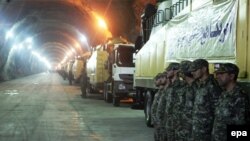The Islamic Revolutionary Guards Corps’ (IRGC) June 18 missile attacks against Islamic State group (IS) in Syria, has dimensions, costs and consequences that go far beyond what IRGC describes as a “retaliation against IS” for the June 7 “terrorist attacks” in Tehran.
After the eight-year Iran-Iraq war in 1980s and before the recent IRGC missile attacks, Iran used its missile capability only once against targets outside its territory.
On April 17, 2001, only weeks before the presidential election in Iran, the incumbent president, Mohammad Khatami convened an emergency session of the Supreme National Security Council. Immediately after the session, the bases of Mujahedin Khalq-e Iran Organization (MKO, an armed anti-Islamic Republic group) in northern Iraq were hit with missiles and artillery fire.
The eight-year Iran-Iraq war had ended, but MKO still had bases all over north and south Iraq. “One thousand missiles and artillery shells were fired at the bases’, MKO declared.
It took seven years for the Islamic Republic to reveal some details concerning the missile attack. More than 70 short range ballistic Scuds had been fired against MKO, whereas during the entire Iran-Iraq war, Iran had only fired 14 missiles. Quantity wise, it was a significant leap forward.
From 2001 onward, Iran has increased its missiles’ accuracy and power of warheads. The United States and its allies in the region have labelled Iran’s ballistic missile capability as a “threat against the region’s security”.
Sanctions and Missile Activities
Iran’s missile activities along its alleged support of terrorism, as well as abuse of human rights were three points of argument at the U.S. Senate for approving a bill of new sanctions against the Islamic Republic.
UN Security Council’s resolution 2231 which after Iran’s 2015 nuclear deal with the world powers (JCPOA) replaced previous UNSC’s sanctions, calls upon Iran “not to undertake any activity related to ballistic missiles designed to be capable of delivering nuclear weapons, including launches using such ballistic missile technology.”
Furthermore, referring to a long list of restrictions, it emphatically adds, “All these restrictions shall apply until the date eight years after the JCPOA Adoption Day (18 October 2015) or until the date on which the IAEA submits a report confirming the Broader Conclusion, whichever is earlier.”
Therefore, Iran is forbidden to have any ballistic missile activities, let alone use it in its extraterritorial military operations. Employing ballistic missiles in extraterritorial operations can easily be considered as an offensive act.
Nevertheless, all of Iran’s ballistic missiles, including Zolfaqar which was used against IS in Deir ez-Zor, Syria, are capable of carrying suitably designed nuclear warheads.
Meanwhile, a commission comprised of eight U.N. members has been devised to supervise JCPOA’s implementation. The commission convenes four times a year in Vienna; mainly to study Iran’s requests and related matters.
However, the other U.N. members can also present their arguments against Iran’s probable violation of the JCPOA.
The United States, as Iran's principle counterpart in nuclear negotiations, has openly declared that in case Tehran violates any article of the agreement, sanctions would immediately be reinstated as they were before the signing of JCPOA. Meanwhile, the U.S. Treasury is in charge of monitoring Iran’s activities to detect Tehran’s probable violation of the JCPOA.
Every three months, he White House and U.S. Treasury review the case to decide whether to extend the suspension of sanctions against Tehran. The IRGC’s recent missile attacks in Syrian could easily lead to ending the suspension.
Political and Security Ramifications of Missile Attacks
On February 1, former U.S. National Security Advisor, Michael Flynn officially warned Iran against its missile test.
Immediately after IRGC’s recent missile attacks, Israeli Prime Minister, Benyamin Netanyahu, also cautioned the Islamic Republic to avoid verbal and practical threats against Tel Aviv.
Israel’s Channel Ten and Times of Israel also joined the chorus to raise concerns against IRGC’s missiles capability, presenting it as a serious threat against Israel’s security. They particularly emphasized that Israel’s security will be “seriously jeopardized” if Lebanese Hezbollah receives Zolfaqar missiles from the Islamic Republic.
Zolfaqar ballistic missile is an advanced version of Fateh 10 and, according to IRGC officials is powered by solid fuel and its accuracy to hit targets is much more than Scud missiles.
Moreover, the Islamic republic has declared that it has successfully produced cluster bombs and according to IRGC officials two warheads of Zolfaqar missiles fired at IS in Syria, were carrying cluster bombs, ostensibly produced in Iran.
Israel’s three layers of defense system against incoming hostile missiles plus the Patriot U.S. air defense system which also covers Arab states in southern parts of the Persian Gulf, cannot offer a hundred percent guarantee to keep the targets safe.
The U.S. military personnel based in the region and in the bases in Qatar, Kuwait, United Arab Emirates, Bahrain and Saudi Arabia have the same concerns as the Israelis. They are in Zolfaqars’ range, as well.
All these regional concerns about Iran's missiles is a factor in heightening the desire to contain Iran. It leads to more isolation, more costs for a never-ending arms race and a negative environment for foreign investments in the country.
Although the cost of firing each Zolfaqar missile is not more than three million dollars, its use can easily lead to the reinstatement of sanctions. Iran’s current economic situation is so fragile that it definitely cannot afford the return of crippling sanctions.











